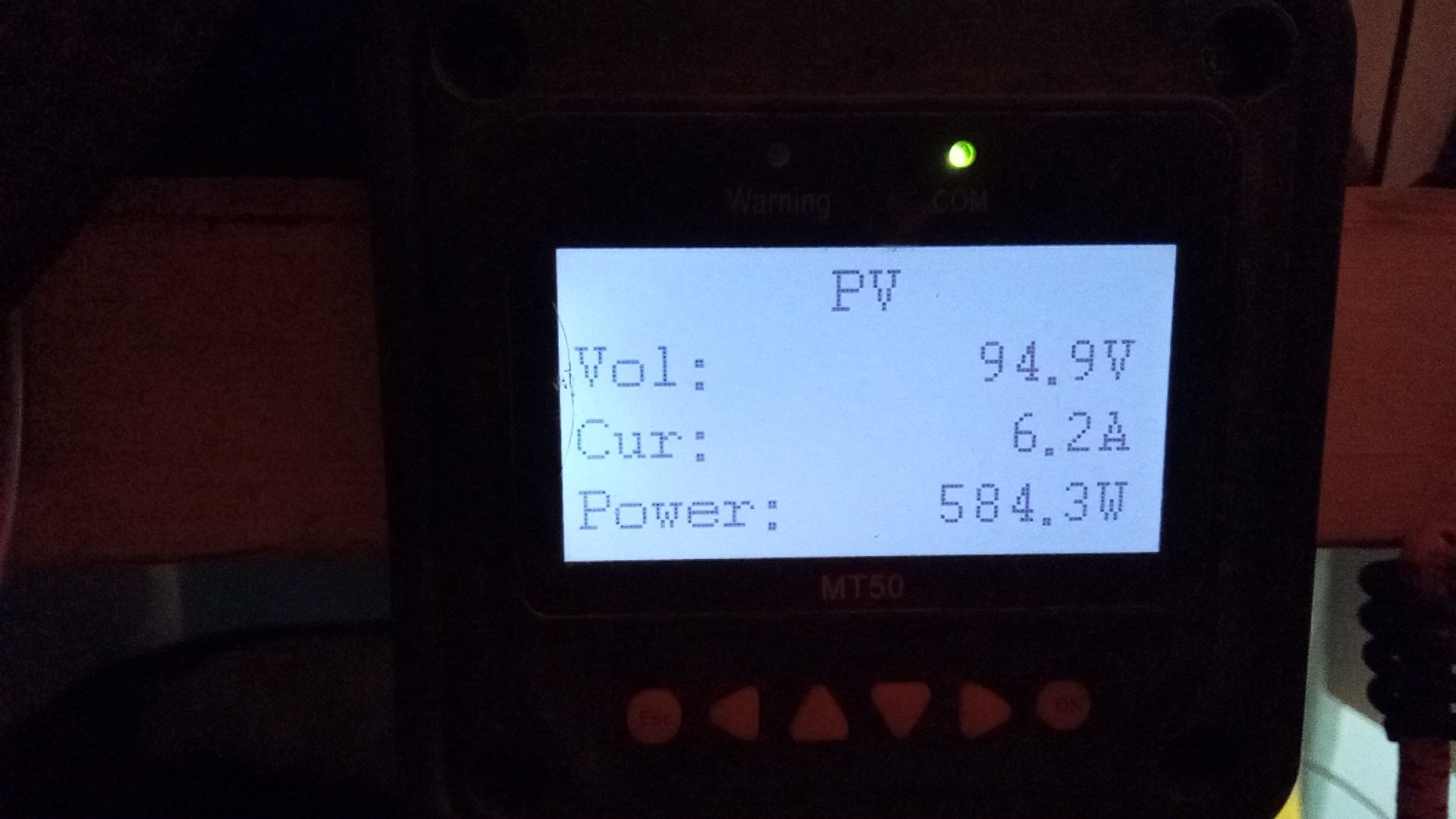anecdote: the economics of overpaneling a charge controller
The upgraded panels have been mounted for about a month and this morning is the first time the controller got close to clipping power at rated current (40A).
Refresher:
- the EpEver 4215BN solar charge controller specs say it is rated for 40A output, which the docs also express at 520w on nominal 12v systems. The math suggests they are using 13v to make calculations, so I will use that below.
- the original 570w array overpaneled the controller’s rated output by ~9.6%
- the new-to-me 750w array overpanels ~44%
- BN specs allow up to 3x overpaneling (1560w!!!) in mild ambient temps.
Since my Vabs / Vfloat values are on the high side to keep the FLA humming actual max wattage @ 40A is somewhat higher than 520w: 40A x 14.7v Vfloat == 588w.
dead horse: clipping is uncommon
Power clipping with overpaneled configurations is relatively uncommon in use cases that do not apply heavy loads. I typically do not run heavy loads. No microwave, no A/C, etc.
In car-guy terms, the overpaneled system is tuned for torque, and the underpaneled-to-normal system is tuned for horsepower. The torquey car will pull hard all the time and almost never hit the rev-limiter; it doesn’t need to. The high-HP car will post impressive numbers at 8,000rpm and flirts with the rev limits.
but this morning…
Sometimes, though, the torquey machine does hit the rev limiter (or get d*mn close). It’s a rare rainy (rainy for the desert) day with complete overcast. I was making ~125w around 0945 when there was a momentary break in the cloud cover. All hands on deck, sailors:


This isn’t clipping proper; these units really will hold the line at precisely 40A if needed. It may have clipped at 40A before I saw it, because when I looked we were already at Vabs 14.7 so current demand was dropping.
bug or a feature?
So is this a bug (unwanted behavior) or a feature (intended behavior)?
I’m just south of Albuquerque. Using those coordinates and time the cosine of solar zenith angle suggests we were getting a theoretical max of 596w of sunlight landing on the array (but see below). Using this metric we could say the overpaneled controller was leaving 12w on the table. IMO spending $200+ a bigger controller would cost is not justified by a +12w gain. Yes, if I win Powerball I’m upgrading to a 60A Morningstar MPPT. :-)
But wait. There are losses in a normally-functioning MPPT system. In this case (~5% DC-DC buck losses, 2% wiring losses, and ~8% temperature derating losses at 50F) the max power extractable should have been something like 521w. Um, what? How are we making 584w?
Given the weather conditions, the most likely explanation is the edge-of-cloud effect (or “cloud-edge effect”). Here’s the clearest explanation of it I’ve seen so far:
Under certain meteorological conditions the solar insolation at ground level can exceed 1000 W/m2. This can happen when sunlight scattered through clouds exceeds the amount of light normally contributed from clear blue sky... > > On a clear day, according to NREL, 85% of ground-level insolation comes from direct sunlight and 15% comes from diffuse light scattered by the rest of the sky... > >
 from https://sky-lights.org/
from https://sky-lights.org/
Observed harvest in watts suggests 1144w/m2 was [momentarily] available, rather than the lab-spec 1000w/m2. (114% of panel rating).
Cost/benefit does not support buying a bigger controller to harvest increased power under Perfect Storm conditions.
conclusion
I am still exceptionally with the setup, and see no need to upsize the controller in my present use case. If I’m only getting near clipping 1x/month then I think the 40A controller is Good Enough.